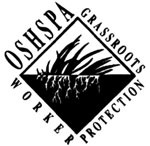 |
August 12, 2003
The Occupational Safety and Health Act of 1970 established OSHA at the federal level, and provided
that states may elect to run their own occupational safety and health programs as long as those
programs are at least as effective as the federal program. Under the approval of OSHA, twenty-six
states and territories operate Sate Plans, twenty-two of which cover both private and public
sector employment, while three states and one territory only cover public sector employment.
The Occupational Safety and Health State Plan Association is an association comprised of states
and U.S. territories that have opted to run their own occupational safety and health programs.
OSHSPA assists member states and territories in carrying out their obligations under the
Occupational Safety and health Act, and serves as a communications link among members, and between
OSHSPA members and the federal government.
The states and territories have frequently led the way in developing innovative approaches to
making America's workplaces safer and healthier. California and Washington, for example, were the
first to have developed state ergonomic standards.
Since the September, 11 2001 attack on the World Trade Center and Pentagon, many states have
established programs aimed at addressing homeland security issues and protecting the safety of
public sector workers whom we rely on during the first minutes of a crisis. State plans are taking
on a leadership role for information sharing and ensuring that state emergency response plans take
the worker safety needs of first responders into account. For example, the Nevada Division of
Industrial Relations has developed response plans that address chemical weapons and radiological
emergencies.
On the following pages, we describe the innovative approaches to creative partnerships, outreach
and education, voluntary compliance, inspection targeting and settlement agreements that have been
developed by the states. If you have questions that I have not addressed, I urge you to call or
write.
Sincerely,
Peter De Luca
OSHSPA Chair
|
CHAIR
Oregon
Peter DeLuca
Department of Consumer & Business Services
Occupational Safety and Health Division
350 Winter Street NE, Rm. 430
Salem, Oregon 97301
(503) 378-3272
FAX (503) 947-7461
VICE CHAIR
Michigan
Doug Kalinowski
Michigan Department of Consumer and Industry Services
Bureau of Safety and Regulations
7150 Harris Drive, P.O. Box 30015
Lansing, MI 48909
(517) 322-1817
FAX (517) 322-1775
PAST CHAIR
Maryland
Keith Goddard
Department of Labor, Licensing & Regulation
Division of Labor & Industry
1100 N Estaw St, Rm. 606
Baltimore, Maryland 21201
(410) 767-2992
FAX (410) 767-2986
DIRECTORS
New York
Richard Cucolo
(518) 457-3518
Utah
Jay Bagley
(801) 530-6898
North Carolina
John Johnson
(919) 807-2861
Hawaii
Jennifer Shishido
(808) 586-9116 |
| U.S. Department of Labor |
Assistant Secretary for
Occupational Safety and Health
Washington, D.C. 20210 |
 |
For more than 30 years, the States and territories operating their own
occupational safety and health programs have been partners with OSHA in protecting America's working
men and women. The 26 approved State plans provide occupational safety and health coverage to over
40 percent of the nation's workforce.
For years, the State plans have experimented with ways to go beyond the basic enforcement of rules
and regulations to involve employers and employees in promoting a culture change in U.S. workplaces
that emphasizes the value of safety and health. OSHA shares this vision. Workplace injuries and
illnesses have been declining for the past nine years - but we must do more. Nationally, we are
seeking to reduce workplace fatalities by 15% and injuries and illnesses by 20% over the next five
years. Promoting a culture change in U.S. workplaces - where every employer recognizes that
occupational safety and health adds value to American business, workplaces, and worker's lives - is
central to achieving lasting safety and health solutions. This Grassroots
report highlights recent State initiatives promoting voluntary compliance and strong employer safety
and health programs, including partnerships and employer recognition programs. I am also pleased to
note that this edition contains a new section on what the States are doing in the important area of
workplace security and emergency preparedness.
The strategic plans of our State plan partners, together with OSHA's new strategic management
plan for FY 2003 to 2008, will support the Department of Labor's goal of fostering quality
workplaces that are safe, healthful and fair. While the States tailor their strategic plans, goals
and targets to their own specific issues and concerns, the outcomes of their activities will
contribute to the achievement of the national fatality, injury and illness rate reduction goals set
by OSHA. This edition of Grassroots focuses on the successful results of
the first five years of State strategic plans.
I continue to be impressed with the talent, ideas and professionalism of our State plan partners,
and their innovative approaches to making workplaces safer and more healthful. Together, we can and
will accomplish our goals on behalf of all workers in America.
John L. Henshaw
Table of Contents: 2002 OSHSPA Report
OSHSPA: States Protecting Workers
Workplace Security: Safeguarding the Workplace
Strategic Plans: Focusing on Performance
Enforcement: Targeting High-Risk Worksites
State Initiatives: Changing the Work Environment
State Incentives: Promoting Voluntary Compliance
State Responsibility: Providing Worker Protections
State Standards: Addressing Specific Hazards
ADDENDUM
State Plan Directory
OSHSPA Board of Directors 2001-2002

Produced by:
Michigan Occupational Safety & Health Administration (MIOSHA)
Bureau of Safety and Regulation
Michigan Department of Consumer and Industry Services
Total Copies Printed: 3,000; Total Cost: $4,390.04; Cost Per Copy: $1.47.
|

